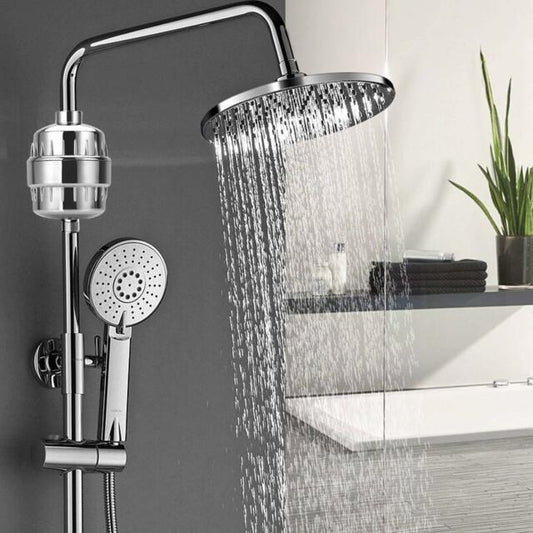In this blog post, we’ll compare these two filtration options based on functionality, cost, installation, and maintenance to help you decide which is the better fit for your household.
What Is a Whole House Water Filter?
A whole house water filter is installed at the main water line, filtering water before it reaches any faucet, shower, or appliance in your home. These systems provide comprehensive filtration for all water used in the house, ensuring clean water for drinking, cooking, bathing, and cleaning.
Advantages of Whole House Water Filters:
Comprehensive Coverage: Filters all water, protecting every tap and appliance.
Long-Lasting Filters: Typically designed to last several years, filtering up to 1 million gallons of water.
Reduces Plumbing Issues: Removes sediment and scale that can damage pipes and appliances.
Better for Sensitive Uses: Provides filtered water for showers, reducing chlorine exposure on skin and hair.
Limitations:
Higher Upfront Cost: Whole house systems often require a larger investment.
Professional Installation: Usually requires plumbing expertise for setup.
For more information on whole house systems, explore advanced filtration options.
What Is an Under Sink System?
Under sink water filters are point-of-use systems installed beneath a specific sink, usually in the kitchen. They are designed to provide clean, filtered water for drinking and cooking through a dedicated faucet.
Advantages of Under Sink Systems:
Targeted Filtration: Ideal for improving the taste and quality of drinking and cooking water.
Lower Initial Cost: More affordable than whole house systems.
Compact Design: Fits conveniently under the sink without taking up much space.
Limitations:
Limited Scope: Only filters water at the specific sink where it’s installed.
Frequent Filter Replacements: Requires more frequent maintenance compared to whole house systems.
Key Comparisons
Let’s break down the differences between these two systems to help you choose the best option for your home.
1. Coverage and Purpose
Whole House Water Filters: Provide filtration for the entire home, including drinking, bathing, and cleaning water. This is ideal for families concerned about contaminants in all household water, such as chlorine or sediment that can irritate skin or damage appliances.
Under Sink Systems: Focus only on drinking and cooking water. These are perfect for households primarily concerned with improving water taste and quality at a single tap.
2. Contaminants Removed
Whole House Filters: Often use advanced media like catalytic carbon and KDF to remove chlorine, chloramines, heavy metals, and sediment. Some systems can also condition hard water without salt.
Under Sink Systems: Typically remove chlorine, lead, and other contaminants affecting taste and safety. Reverse osmosis (RO) under sink systems can even remove dissolved solids and bacteria.
3. Installation
Whole House Filters: Require installation at the main water line, which usually necessitates professional help.
Under Sink Systems: Easier to install and can often be set up as a DIY project.
4. Maintenance and Lifespan
Whole House Filters: Offer long-lasting performance with filter changes required only every few years.
Under Sink Systems: Require more frequent filter changes, often every 6-12 months.
5. Cost
Whole House Filters: Higher upfront cost but lower long-term cost due to the longevity of filters and broader benefits.
Under Sink Systems: Lower initial cost but may result in higher long-term costs due to frequent filter replacements.
Which System Is Right for You?
Choose a Whole House Water Filter If:
You want filtered water for every use in your home, from drinking to bathing.
Your water supply contains high levels of chlorine, sediment, or other widespread contaminants.
You’re looking for a long-term solution with minimal maintenance.
Choose an Under Sink System If:
You only need clean water for drinking and cooking.
You’re on a budget and want an affordable filtration option.
You live in an apartment or rental property where whole-house systems aren’t practical.
Why Not Both?
In some cases, combining both systems can provide the best results. For example, a whole house water filter can handle the primary filtration for your entire home, while an under sink system provides an additional layer of purification for drinking water.
This setup is particularly beneficial in areas with hard water or high levels of specific contaminants.
Final Thoughts
When it comes to water filtration, there’s no one-size-fits-all solution. Whole house water filters are ideal for comprehensive coverage, protecting your home and family from widespread contaminants. On the other hand, under sink systems are perfect for targeted filtration, improving the quality of drinking and cooking water.
Assess your water quality, household needs, and budget to determine which system aligns with your priorities. If you’re still unsure, consider consulting a water quality expert or visiting trusted resources like the Environmental Protection Agency (EPA).
For a long-term investment in clean, safe water, explore advanced and eco-friendly filtration systems that meet your home’s unique needs.






